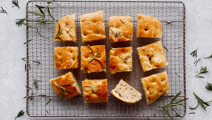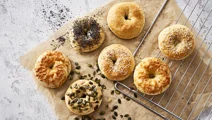Pita bread
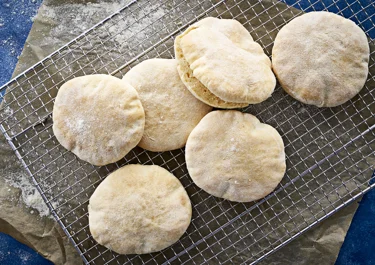
Nothing compares to soft pillowy homemade pita bread. The only thing making it better is stuffing freshly baked puffy bread with your favourite fillings, especially when you have baked it yourself. Try our easy recipe and discover the simple pleasures of warm, traditional Greek pita bread served for dinner or a luscious lunch.
Ingredients
|
150 ml
Milk
|
|
|---|---|
|
150 ml
Water
|
|
|
25 g
Yeast
|
|
|
½ tsp
Sugar
|
|
|
½ tsp
Coarse salt
|
|
|
60 g
(approx. 1 dl) durum flour
|
|
|
375 g
(approx. 6¼ dl) pizza flour
|
Instructions
Tips
When making pita bread, the water must have the right temperature to dissolve the yeast. Yeast makes the pitas rise, but if the water is too hot, it will kill the yeast, and the bread will not rise. Likewise, if the water is too cold, the yeast will not activate, resulting in flat pita bread. Ideally, the water should have a temperature somewhere between 32-38°C.
Tips
Be sure to add the last of the flour little by little. It may be tempting to add it all at once, especially if the dough feels sticky, but you need moisture in the dough to make the Greek bread puff in the oven. So, if you add too much flour, you will end up with dry dough. It is important to flatten the bread as evenly as possible; otherwise, it might puff more in some areas while staying flat in others.
Questions about pita bread
Making pita bread at home is straightforward and effortless with our easy pita bread recipe and a few basic but well-picked ingredients. Read on and learn how to make soft, fluffy, golden-brown pitas that you can stuff with delicious and tasty fillings.
What is pita bread?
Pita bread is a Greek leavened round bread with a soft and slightly chewy texture. Greek bread is typically baked on a stone surface with yeast, water, and flour. It often features a pocket that can be stuffed with various fillings but is also used as a snack for dipping in hummus or the like. When pitas are baked at high temperatures, the water in the dough turns into steam, making the bread puff up and form a pocket to hold delicious fillings. The round flatbread is very common in Mediterranean and Middle Eastern cuisine.
How to make pita bread?
We have added a few extra ingredients to our pita bread recipe to make the bread extra fluffy and tasty. Heat milk and water and stir yeast into the mixture. Add the rest of the dry ingredients and knead the dough until it pulls away from the sides of the bowl. Divide it into 12 pieces and shape each into buns. Flatten the buns and let them rise for about 15 minutes before baking them in the oven for 7 minutes at 250°C.
Can you freeze pita bread?
Pita bread freeze well, and it is a great way to extend the shelf life of the bread. Allow the bread to cool and place a square of baking paper between each piece of bread. This prevents them from sticking to each other during freezing. Place the bread in a big airtight freezer bag or container and freeze for up to 3 months. To avoid freezer burn, consider wrapping the pitas in cling film and foil layers, especially if you plan to keep them in the freezer for more than a month.
How to reheat pita bread?
You can use different methods to thaw and reheat pita bread. To reheat the bread in a non-stick pan, place the bread in the pan at medium heat for 2-4 minutes before flipping the pitas to the other side and leaving them for 1-2 minutes until they are defrosted and warm. Another method is to let them thaw at room temperature on the kitchen counter for 30-60 minutes, after which you can warm them on the stove for a couple of minutes. If you are microwaving the pitas, do no more than 3 at a time and microwave in 20-30 second intervals. It is a good idea to place a damp paper towel on top of the bread when using this method, as this will prevent them from drying out. Finally, you can also reheat the round bread in a preheated oven at 180°C for about 5-7 minutes.
How to store pita bread?
Pita bread is kept best in a freezer bag or bread box to retain the quality of the flatbread and prevent them from drying out too quickly. Store the bread at room temperature or in the fridge, and make sure to squeeze out as much air as possible if you are using a freezer bag for the bread. We recommend letting the pitas sit on the kitchen counter if you plan to use them within the first couple of days.
How long does pita bread last?
Pita bread can typically last up to a week when stored properly, after which the flatbread will start to dry out and eventually go stale. However, for the best taste and quality, it is best to enjoy the bread within the first 3-4 days of baking them while the bread is still soft to the touch.
Make your own soft pita bread
Few can resist the warm smell of delicious, fluffy, and puffy pita bread. Our recipe is simple and only requires a few ingredients, most of which you already have at home so you can easily enjoy this fresh, warm, perfectly delicious homemade creation. The soft bread has an empty round pocket that is just waiting for you to stuff it with your favourite pita bread fillings and dressings. You can even rip the bread into bite-sized pieces and dip it in soups and stews. It is the perfect bread to serve as a main dish or a companion to countless other delicious meals.
In need of inspiration for your pita bread fillings? Take a look at our recipe for falafel with chickpeas, crispy on the outside and soft on the inside, or try your hand at our butternut squash salad, Greek salad, or maybe hummus for both flavour and delicious dressing.
The traditional Greek bread
This traditional puffy Greek bread is a staple in countless Greek dishes. Though Greece is said to be home to over 70 different types of bread, pita bread is by far one of the most popular and world-renowned choices. These savoury and scrumptious bread are baked at high temperatures, turning the water in the dough into steam, thus allowing the pita to expand and create a magical little pocket that sets this bread apart from so many other types of flatbreads.
Delicious fillings for pita bread
These pita bread pockets are perfect for transporting delicious fillings for a quick lunch on the go. There are no limitations when it comes to picking a filling for your bread. Make it Greek style with chicken gyro, creamy tzatziki, and lettuce, all wrapped in a warm and soft pita. A perfect balance of herbs and aromas that will blow you away. For a filling with extra veggie crunch, make a lemon-marinated bean filling and toss beans, onions, tomatoes, celery, and herbs. Mix lemon juice and zest with garlic, olive oil, salt, and honey and pour over the bean salad. Combine the dressing and salad and stuff the honey-lemon flavoured mix into your pita.
You can even make a dessert version that the kids will absolutely adore. Simply put some hazelnut spread and maybe even whipped cream or a few sliced berries inside.
Make it your own
Elevate your pita bread with seasonings for extra flavour. Knead and shape the dough per the instructions in the recipe and let it rise while preparing the seasoning for the bread. Mix olive oil, smoked paprika, garlic powder, and Italian seasoning, which combines several different dried herbs such as basil, rosemary, and oregano. Spread the mixture all away to the edges of the pitas right before placing the bread in the oven. The combination of spices and herbs makes for a refreshing and aromatic experience that is hard to resist and undoubtedly demands seconds.


&format=webp)


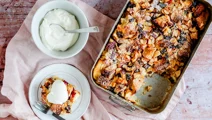
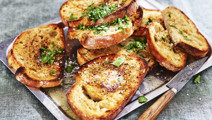&format=webp)
